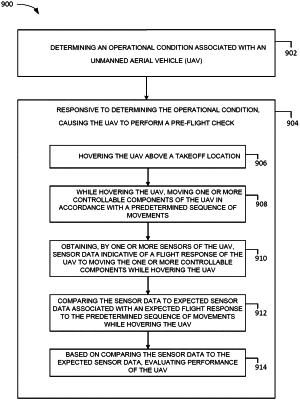| CPC B64D 45/00 (2013.01) [B64C 39/024 (2013.01); G08G 5/0013 (2013.01); B64D 2045/0085 (2013.01); B64U 2201/10 (2023.01); B64U 2201/20 (2023.01)] | 20 Claims |

|
1. A method comprising:
determining an operational condition associated with an unmanned aerial vehicle (UAV); and
responsive to determining the operational condition, causing the UAV to perform a pre-flight check, wherein the pre-flight check comprises:
hovering the UAV above a takeoff location;
while hovering the UAV, (i) moving first one or more controllable components of the UAV in accordance with a predetermined sequence of movements to apply a force to the UAV and (ii), in response to moving the first one or more controllable components, moving second one or more controllable components of the UAV to attempt to maintain at least one of a position or an orientation of the UAV along at least one axis by correcting for the force applied to the UAV by moving the first one or more controllable components;
obtaining, by one or more sensors of the UAV, sensor data indicative of a flight response of the UAV caused by moving the second one or more controllable components while hovering the UAV, wherein the sensor data comprises torque data indicative of torque applied by the UAV on one or more of a roll axis, a pitch axis, or a yaw axis while moving the second one or more controllable components to maintain the at least one of the position or the orientation of the UAV;
comparing the sensor data to expected sensor data associated with an expected flight response to the predetermined sequence of movements, wherein comparing the sensor data to the expected sensor data comprises comparing the torque data to one or more of (i) an expected roll torque when operating to adjust a roll of the UAV, (ii) an expected pitch torque when operating to adjust a pitch of the UAV, or (iii) an expected yaw torque when operating to adjust a yaw of the UAV; and
based on comparing the sensor data to the expected sensor data, evaluating performance of the UAV.
|